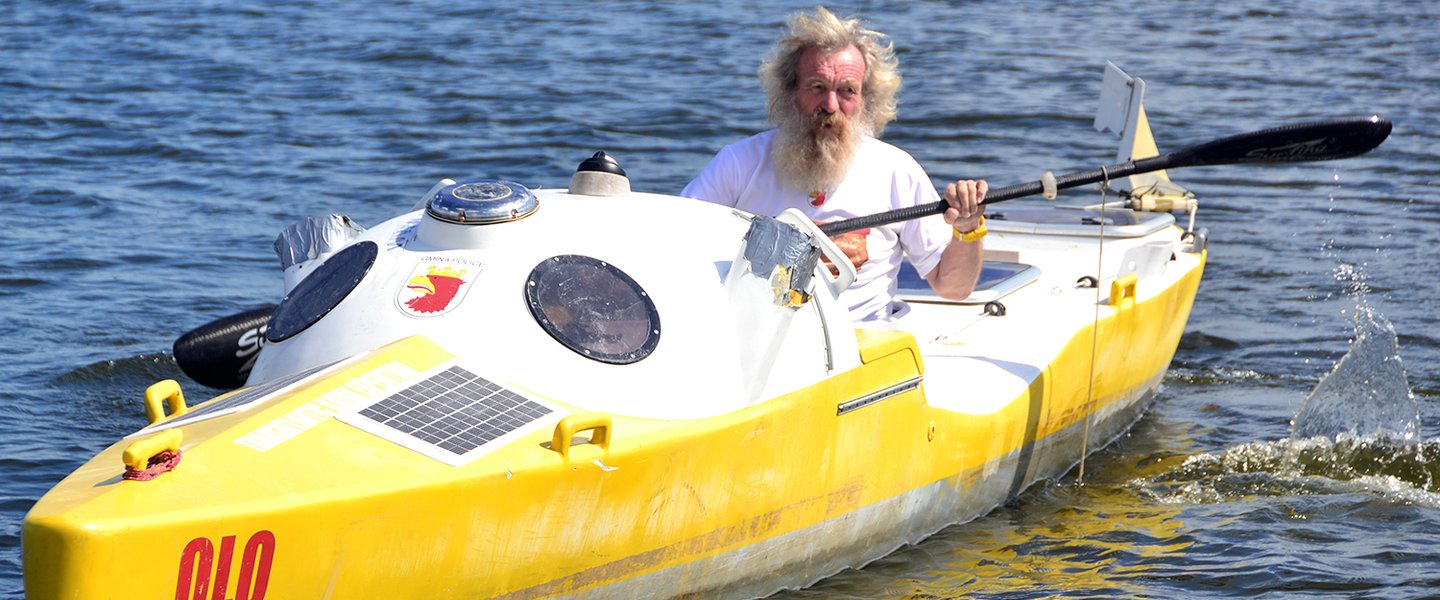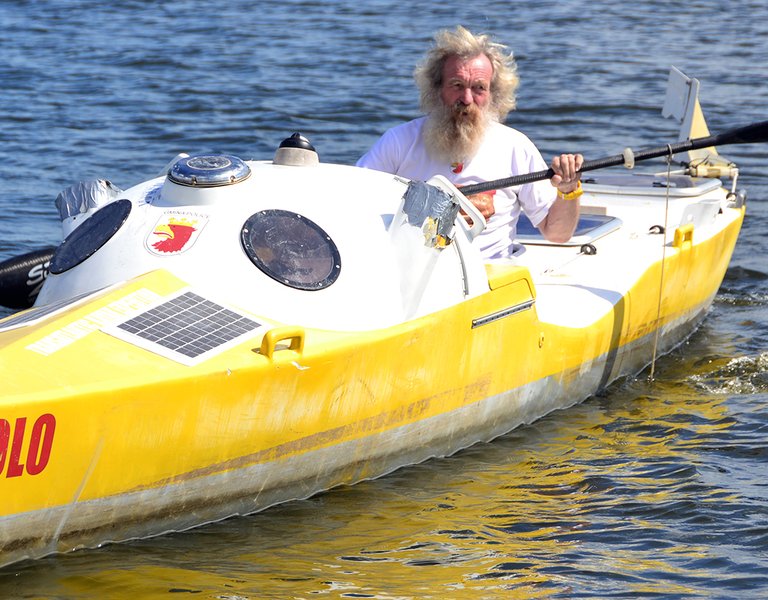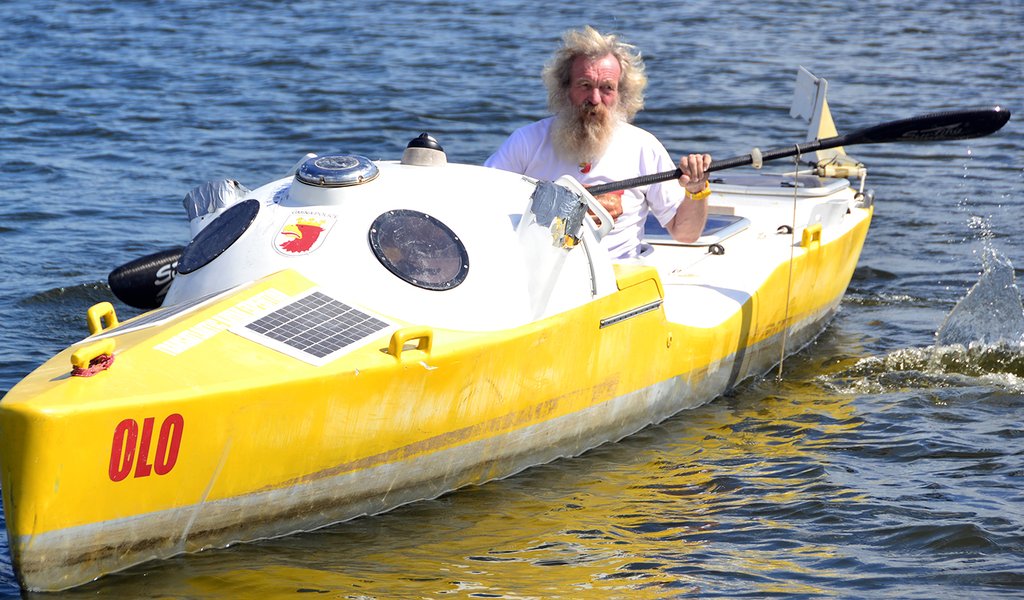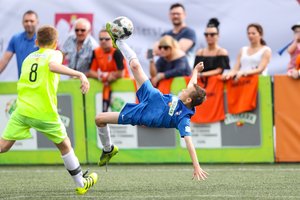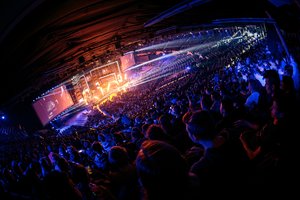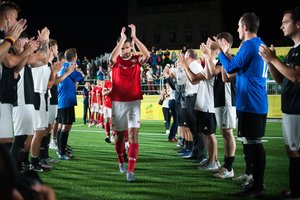A Kayak Odyssey from Europe to America
The first person in the world to paddle from Europe to America in a kayak across the Atlantic Ocean’s widest point, Aleksander Doba also holds the record for the number of days (142) spent in a kayak in the ocean. The 68 year-old mechanical engineer from the Polish city of Police, talked to Polska.pl about wind traps, the glistening green ocean as well as the Drawa, his favourite river in Poland.
Magdalena Majewska, Polska.pl portal: Had you always dreamed of crossing the Atlantic Ocean? How did the idea come about?
Aleksander Doba*: It actually wasn’t my idea, I swear. Eleven years ago a complete stranger approached me with the idea. His name was Paweł Napierała from Zielona Góra and he was a researcher in the Philosophy Department of the University of Zielona Góra. He convinced me to cross the Atlantic in a kayak. The argumentation skills of a philosopher trumped the realist outlook of an engineer. After facing various setbacks we started our journey in 2004 in Ghana, but we only spent 42 hours in the ocean because we were ill prepared. However the idea to cross the ocean was lodged firmly in my head and I decided to give it a shot on my own. I started by searching for a boat manufacturer who could build me a suitable kayak. That’s how I reached Andrzej Armiński’s shipyard in Szczecin, which builds oceanic yachts. After talking to him for a few hours I managed to persuade him to design and build for me a kayak that would be safe enough for the ocean. I became fascinated with the history of previous attempts to cross the ocean in a kayak. It’s a pretty short history actually: the Atlantic Ocean has only been crossed three times by kayakers.
The first time was in 1928 by the German captain Franz Romer. He travelled from the Canary Islands to the Caribbean in 56 days. He then rested for a few months before trying to paddle from Puerto Rico to New York, but he died in a hurricane within the Bermuda Triangle. In 1956, another German, Hannes Lindemann, also set off from Las Palmas in the Canary Islands and managed to reach the island of Saint Martin in the Caribbean. Unlike his predecessor, he went on to live a long and happy life. And that is all in that direction. In 2001, Peter Bray from Great Britain made it from the island of Newfoundland to Ireland. But no one else. They all kayaked from island to island. What I wanted to do is kayak from continent to continent. I was the first person in the world to do that. I started in Dakar, the capital of Senegal in Western Africa, and I paddled all the way to South America – to Acarau in Brazil. It took me 99 days, just over three months. This was the most narrow stretch of the Atlantic. I then decided to raise the bar and kayak across the widest part of the Atlantic. I started this second excursion on 5 October 2013 in Lisbon, Portugal, with the aim of reaching New Smyrna Beach in Florida. Everything was going fine until my rudder broke down within the Bermuda Triangle. The rudder simply broke off. I had to return to shore, to Bermuda, and I then took a break for one month. I continued my journey, crossing the ocean within 167 days. The Lisbon-Bermuda stretch took me 142 days and that is to this day the longest amount of time spent in a kayak on the open ocean. I beat my previous record of 99 days. On top of this were the 25 days it took to reach Florida, adding up to a total of 167 days for the journey from Europe to North America.
What surprises did you encounter during the almost six months that you spent sailing on your own across the open ocean?
As a student at Poznan’s University of Technology, during my compulsory military training, I was told “the enemy you know is less dangerous.” I never treated the ocean as my enemy. I knew that I would be spending several months at sea. I tried to inform myself of the things that I could encounter: for example, what do waves and storms look like, how to prepare yourself for them. I spent many hours in the library of Szczecin’s Maritime University. I talked to sailors. I knew what ocean waves were like in theory. I did my homework and it prepared me well. The accounts of the ocean that I heard during my preparations proved to be accurate and I was able to meet the challenges I faced. During my second excursion I weathered 8 storms, the longest of which lasted three days – and the waves were up to 9 meters high. I made sure to adjust my kayak so that its nose faced the waves. This helped bear the brunt of each wave offensive. The kayak was brave, and so was I. I was not afraid at all, because the kayak has two crucial characteristics. First, it is unsinkable. The kayak had several compartments filled with a light, stiff and impermeable material. Even if you were to open the hatches to the cabin and the luggage compartments, pierce holes in many places and force the kayak under water, it would still not sink. Second, this kayak could not capsize. If the waves would turn it upside down, the kayak would still return to its natural position due to the unstable equilibrium. These two characteristics guaranteed my safety. I was not worried, not even once, that something would happen to me.
Sir Ernest Shackleton, the Irish polar explorer, once said that: “The sea is an element that cannot be conquered. One can merely make sure that it does not defeat you.” I take the liberty to replace the word “sea” with water in general. I encourage everyone to have respect for the natural element that is water. This includes everyone who cross rivers, kayak and sail on boats and surfboards. We shouldn’t want to defeat it. Instead we should concentrate on staying afloat, having a good time and treasuring our lives. When people tell me that I conquered the Atlantic, I reply that this is not the case. I only sailed across the Atlantic without suffering defeat myself. It was not some sort of wild, spontaneous journey. I prepared myself very well for it.

Water is an element that cannot be conquered. One can merely make sure that it does not defeat you. When people tell me that I conquered the Atlantic, I reply that this is not the case. I only sailed across the Atlantic without suffering defeat myself - Aleksander Doba
Did you come across any interesting natural phenomena while sailing across the ocean?
For me, the Atlantic was a great novelty. I admired its diversity and the various creatures, big and small, which swam in it. I was fascinated by the phenomenon of bioluminescence. Woken up by a mechanical movement, such as the swish of a paddle, micro-organisms swimming in the ocean would emit a green light for around one second. When I paddled in the ocean, especially when there were no big waves, I would see how my oars would create this green glow. A drop of water would glow for a moment before it hit the deck. The green glow would be carried on the back of small waves as I paddled. I found it interesting how sometimes it would be impossible to see a big fish swimming just below the surface of the water, because all you would see is the green glow everywhere. The size of the fish could be determined by the shape of the glow.
One day I had the feeling that I was being watched from behind. I felt that someone was staring at me. The ocean was peaceful, no one in sight, and yet I felt watched. I look behind me and, not more than 20 meters away from me, is the enormous head of a whale. This was an amazing experience that lasted a few minutes. I stopped rowing. We stared at each other and then the whale swam past me. This enormous creature, almost 20 meters long, right next to me. I was not scared. But the closeness of this gigantic animal was fascinating. I saw dozens of sharks, but I was not scared of them either. The sharks were several meters long – usually between 3.5 meters and 4 meters in length – while the kayak that I was sitting in measured a length of 7 meters. Several sharks would barge into the kayak, in order to find out what it is: if it is soft it could perhaps be edible. I would sometimes hit them with an oar, just to see what they would do. But there weren’t as many sharks as people said there would be.
What was the most beautiful moment of your journey?
I was stranded in the Bermuda Triangle for over one and a half months, 47 days, because of a wind trap which eventually caused my rudder to break off after the fifth consecutive storm. I had to reach shore, Bermuda was the closest, but didn’t have the means to do so. My friend Piotr Chmieliński, together with a television crew and two captains, five people in total, were eager to see me and decided to sail 200 km in order to meet me. After months of solitude I knew that I would see people again. Not just people waving at me from a passing ship, but actually people who were coming to see me. I was happy that I was going to be able to finally talk to people again. It was a special occasion for me. I cleaned myself up as well as the kayak – what a great joy. When they arrived they told me that they were expecting to find me tired and frustrated by my broken rudder – but instead they said that I was gleaming with energy and happiness. It was the most amazing three hours.
What did your daily routine look like when you were out in the ocean?
I sailed day and night, although I slept only at night, as I was not able to do so during the day. In the tropics and the subtropical regions, the main areas that I sailed through, days and nights are both 12 hours long. I usually rowed for eight to twelve hours each day. The heat often made it impossible for me to row during the day, in which case I rowed at night under a cloudless sky filled with stars. I used to look at the stars and identify new ones with the help of a book that I had with me called ‘Which Star is This’ which had an overview of all star constellations. I saw shooting stars and made sure to make a wish each time I saw one. These were wonderful hours. The mornings were very pleasant, especially just after sunrise. During this time I could still row because the air was crisp. Later I had to protect myself against the sun and the heat. Towards the end of the day, when the sun was already very low, I could start rowing intensively again. All my food was lyophilized, free of water. I had a small propane butane gas stove, which was effective but I mainly used it to boil water. I made a lot of coffee. The process of preparing food would be as follows: I would open tightly sealed aluminium bags, pour their contents into a thermos with a wide opening and then add boiling water. I would then mix thoroughly, close my thermos and wait six to seven minutes until the food was ready.
I had four different types of soup and a couple of dozen main courses to choose from. I also had six types of lyophilized fruit. And a lot of sweets, so that I wouldn’t lose too much weight – during my first excursion, which lasted 14 weeks, I lost 14 kgs. In the second journey I only lost 10 kgs, although it lasted longer. I did however crave for ordinary Polish bread and boiled potatoes during my time at sea. The joy of eating them again for the first time in six months was unforgettable. Apart from eating and rowing, I also fixed equipment. I am a mechanical engineer and designer, so I was able to mend parts of the kayak when necessary.
Having very few tools and materials at my disposal, I adapted and refined certain things using waste materials. Waves were a constant problem during my journey and ventilation was poor due to the fact that the cabin of the kayak was pretty small, just slightly bigger than a coffin. As a result, I had to sleep with a half-open manhole, with my head right at the opening. Between one and two litres of water dripped on my head while I slept. This was very annoying. I decided to make use of a box, meant as a surplus food container, made for me at the shipyard shortly before my departure. Instead of disposing of the box after eating the food inside, I used it as an extra layer of protection against waves. I created a complex shape with a blade used to cut metal. I spent eight hours cutting, hurting my hands in the process, as I had to hold the blade with my bare hands. I strengthened the entrance to the cabin with the box and used a knife to poke holes in the hull, because I didn’t have a drill. It worked very well. I also managed to use the box to create a self-steering device, so that the wind would not push the kayak too much off course when I slept. It worked very well at the helm – on three occasions the waves destroyed it, but I managed to fix it.
How did you celebrate Christmas Eve when you were alone at sea?
During my first journey I sent out Christmas greetings via text message. My second excursion was more quiet. On 20 December 2013 I failed to notice that the pre-paid credit on my mobile phone was running out. I sent out text messages with my festive greetings until, suddenly, they would not send any more. I was unable to ask my family to top-up the credit on my phone, which prompted family members to send me worried messages along the lines of “Olek, are you okay?” and “We’re worried that you’ve stopped writing to us.” That’s why on 23 December, a day before Christmas Eve, I sent out a special message using a different device. It was signal asking for assistance. I assumed that they would understand. Instead, they interpreted the signal as an emergency call for “Help.” An alarm was sounded across the Atlantic and a Greek merchant vessel sailed towards me. I told the crew that I was merely having problems with my phone and that I was not in need of being rescued. Soon thereafter the world found out that I have troubles with my phone. However, it took a total of 47 days, that’s over one and a half months without connectivity, for people to realise that the problem lay in my lack of credit. So my Christmas holidays were very peaceful, free of phone calls. Unfortunately, a website posted misleading information saying that my phone was not working, even though both of my phones were completely functional. As a result, quite a few people stopped sending me messages altogether, which made me sad.
What are your plans for the future? Which waters do you plan to cross next?
As a young person – I am, after all, only 68 – I still have a lot of plans. I want to prepare myself for much tougher challenges after making some modifications to my kayak. On 14 May 2016 I intend to set out from the New York coast and make my way to Europe. In terms of distance, it would be similar to my previous journey but it would be tougher as the water is colder, with a higher probability of storms. An ambitious endeavour.
Where in Poland do you enjoy sailing? Which trails would you recommend to beginners as well as to more advanced kayakers?
Kayaking on rivers is the most pleasant. I can sincerely recommend one river: it was the first river on which I kayaked and, to this day, my favourite. This is the Drawa River in the Drawieński National Park. Beautiful, varied and 200 km in length, it has easy as well as challenging spots. The Drawa is one of several classically beautiful rivers in Poland, alongside the Czarna Hańcza, Krutynia, Wda, Brda as well as the mountain rivers Poprad and Dunajec in the south. I also really enjoy paddling down rivers during the winter, for example on the Brda River which is full of snow and has frozen coastlines during that time of year. What is popular these days is so-called logjam kayaking. This involves making your way down narrow rivers with lots of trees on both sides and fast currents which are hard to manage. It is something for advancing kayakers. These are mainly mountain rivers, of which there are 18 in Poland. The most difficult river in Poland is the Kamienna River close to the town of Szklarska Poręba. Poland’s National University Championship in Whitewater Kayaking takes places on the Kamienna River. Upon seeing the river, the average tourist would deem paddling down the river impossible. But it is possible. In Poland one can also paddle down in sea along the coastline.
What do you like about Poland?
When I reached the United States in my kayak, my first steps on American turf were made wearing two t-shirts. One of the t-shirts had the map of my journey on it. The other one had a white eagle on it and the word “Polska” written on the back in big letters. I was proud that as a Pole I was able to cross the ocean and do something great. I showed the world what Polish people are capable of.
Put in perspective of the ocean, our country is small – but it is also great and interesting. We have mountains in the south, the sea in the north, a country full of beautiful rivers. Before I started praising Poland abroad, I made sure to discover the country for myself. Poland once had 49 provinces – I kayaked through 48 of them. I discovered Poland in my kayak. I love to sail on rivers. Polish rivers are wild and increasingly clean. I love Poland for its diverse river network. And I love it for my beloved Drawa River, the pearl of Polish rivers.
Interviewed by MAGDALENA MAJEWSKA

*Aleksander Doba – Polish traveller, kayaker born in 1946 in Swarzędz. He worked as a mechanical engineer in a chemical plant in the city of Police, where he lives to this day. He was the first kayaker to sail across the entire Polish coast from Police to Elbląg, as well as the first to diagonally cross Poland from Przemyśl to Świnoujście and the first to sail the entire length of the Wisła River. He is also the first person in the world to singlehandedly cross the Atlantic Ocean, from Europe to America, in a kayak at the Ocean’s widest point (in October 2013 – April 2014). He has won numerous medals at Poland’s National University Championship in Whitewater Kayaking. Doba has also done paragliding and parachuting. In 2015 he was chosen Adventurer of the Year by the American magazine National Geographic.
11.06.2015
